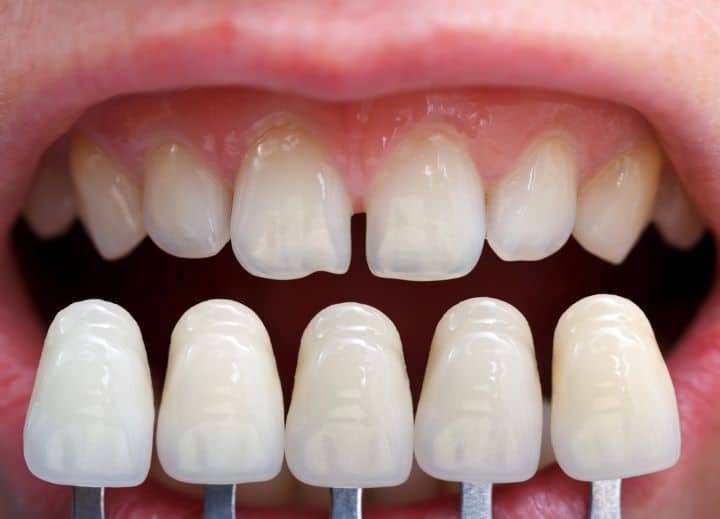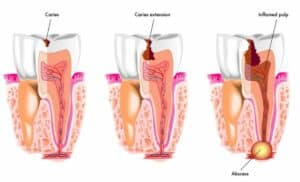It is estimated that about 178 million Americans are missing at least a tooth.

They go to a dentist in search of a solution that will not only enhance their quality of life but also provide a safe and permanent solution for their lost teeth. As a dentist, my recommendation, time and again, is to opt for dental implants, as implants are a native-like substitute for natural teeth.
What Are Dental Implants?
An implant is a titanium screw that surgically goes into your jawbone, and after it heals, you receive a crown or a prosthesis that’s screwed or cemented onto it.
More specifically, it’s a medical device that lays a strong foundation for your dental prosthesis (crowns, bridges, or dentures) to improve your eating, speaking ability, and overall appearance.
The excellent news is implants aren’t destructive at all. These won’t damage any of your neighboring sound teeth during the replacement. It means it’s a highly conservative treatment option available at all times.
Why Tooth Loss Happens
According to the American College of Prosthodontics, 178 out of 340 million Americans are missing at least one tooth, while 40 million are missing all. This means almost 50% of the American population faces the problem of missing teeth.

There are a lot of reasons for it. A few important ones are:
- When you don’t take good care of your oral health, it can lead to tooth decay, gum disease, and problems with the bones that support your teeth.
- A dry mouth due to medications or menopause increases the risk of tooth decay and gum disease.
- A carbohydrate-rich diet and adopting habits like smoking contribute to oral diseases.
- Gene predisposition.
- Trauma
These issues can ultimately result in the loss of your teeth.
When Were The Implants Invented?
Implant dentistry is the second oldest dental profession, next to oral surgery. In 600 AD, the Mayan population used shells to replace the teeth in the lower jaw. 1809, J. Maggiolo introduced a gold implant tube into a recently extracted tooth socket.
The Strock brothers adopted Vitallium screws in 1930 to replace missing teeth. Formiggini and Zepponi, often called the pioneers of modern implantology, developed a post-type endosseous implant in the 1940s. Simultaneously, Dahl in Sweden pioneered the subperiosteal implant during the same era.
Advantages of Dental Implants?
As of today, an implant is the best option to replace a missing tooth for five main reasons:
Highest Success Rate
It offers the highest success rate, up to 97%, with minimal chances of prosthetic failure. Unlike a dental bridge that can last up to 10 years, it can last a lifetime, making it a one-time, long-term prosthetic investment only if you promise to maintain oral hygiene and overall health.
Behaves Like A Natural Tooth
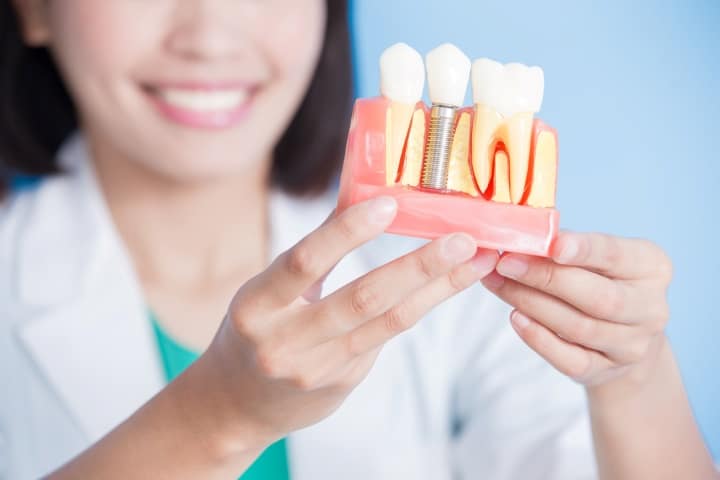
A dental implant mimics a tooth root that fuses with the jaw bone through osseointegration. Once the integration happens and the implant naturally fixes into your bone, a prosthetic crown, bridge, or denture is given. The innate capability of an implant to bear the load restores the chewing power and the esthetics equally.
Prevents Bone Loss
The natural tooth root stimulates our jaw bone, keeping it intact throughout. Likewise, implants provide stimulus to our bone, preventing overall bone loss. If you don’t get an implant within the first year after losing a tooth, the bone in that area shrinks by 25% in volume, and this bone loss continues as the years go by.
Preserve The Adjacent Tooth
Unlike a bridge, which necessitates root canal treatment for the neighboring teeth next to the gap left by the missing tooth, implants provide a self-contained and minimally invasive solution. It helps prevent the health of the surrounding tooth structure, keeping the procedure conservative and time-saving.
Prevents facial sagging And Premature Aging
Facial sagging is one of the side effects of bone loss, which is a carried forward effect of tooth loss. This effect is majorly seen in the lower third of the face, resulting from a reduced distance between the tip of the nose and the chin. Moreover, it gives a witch chin appearance, which makes you look old.
Types of Dental Implants
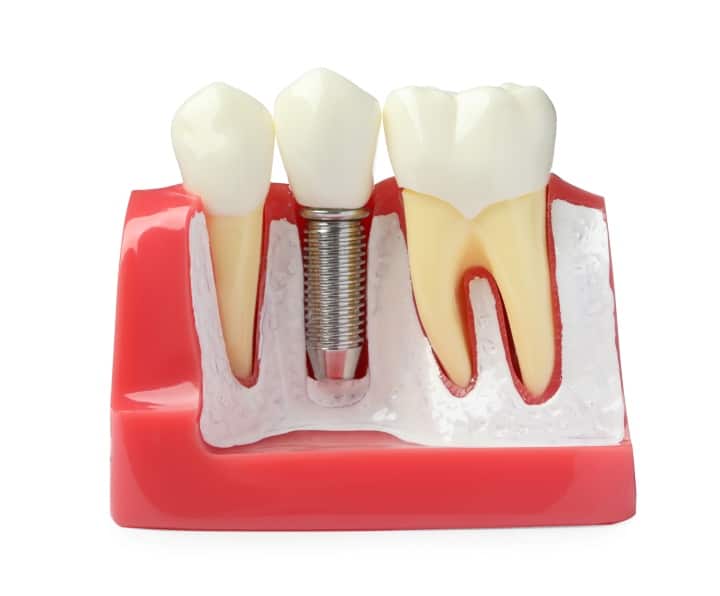
Generally speaking, there are two types of implants.
Endosteal Implant
The most common type of implant that goes inside your jawbone mimics an artificial root of your tooth. Typically, a titanium screw that would later on hold the artificial crown part of the tooth. This makes a complete tooth with a root and a crown.
Subperiosteal Implant
If your bone is not healthy enough to support an endosteal Implant, your dentist might prescribe you a subperiosteal implant. Such implants are placed on or above the jaw bone beneath the gums to hold the replacement tooth.
Implants Vs. Dentures
| Implants | Removable Dentures |
| Permanently fixed option | Removable option, interim |
| Require sufficient bone for placement. | Can be fitted regardless of bone quantity. |
| Titanium screw inside the bone | Acrylic denture above the bone. |
| ~$1600 per tooth | ~$1600 per arch |
| Better stability & retention | Lesser stability & retention |
| Needs no renewal | Needs renewal |
| Popular option | Less popular option |
| No overnight removal | Requires overnight removal |
| Peri-implantitis is the major complication | Denture stomatitis is the major complication |
Pre-Implant Placement Procedures
Dental implant placement depends majorly on the health of the jawbone and your overall health. Sometimes, if you’re healthy enough, that means you have no medical conditions like diabetes; you might need some additional surgical procedure to aid the placement of the implant. American Academy of Implant Dentistry discusses and supports the techniques to rebuild the bone and to provide a healthy foundation for dental implant placement.
Bone Augmentation

Dental implants require a healthy jaw bone. If you have massive bone loss due to poor oral hygiene or systemic conditions, or maybe you lost your tooth a decade ago, you need a supplementary bone to support the implant.
Usually, bone is grafted from the self structures like jaw bones or an artificial bone made up of biocompatible material infused at the desired site. Sometimes, membranes are also used to aid the guided growth of the bone.
Sinus Lift Procedure
Sinus are the air-filled spaces that have close proximity to your posterior teeth. As the name suggests, the sinus lift procedure lifts the sinus to provide sufficient bone in the upper jaw for placing a dental implant.
The oral and maxillofacial surgery must take place before the placement of the implant into the jaw bone, in some cases, for the success of the implant procedure. The procedure requires placing bone graft material into the socket to create a scaffold for your bone to grow. This might take time varying from 4 to 12 months.
Extractions
The extractions of residual roots or an infected tooth are also required before the placement of implants. Sometimes, an implant placement is immediately followed after extraction to preserve the bone quality, leading to no need for bone augmentation.
Getting a Dental Implant, Step-by-Step Procedure
Implantology seems to be a more straightforward procedure but involves several stages. Usually, maxillofacial implant placement is a multi-disciplinary process involving a general dentist, oral and maxillofacial surgeon, and a prosthodontist simultaneously. However, a dental implant may be placed only by a general dental surgeon if the case is straightforward and requires no pre-surgical procedures.
Diagnosis & Treatment Planning

To place dental implants, a dental team needs to work out. A meticulous oral and radiographic examination is carried out to assess the quality of bone, the proximity with sinuses, and the nerves.
Usually, a panoramic radiograph of your jaw, commonly known as OPG and a CBCT, are the accurate investigations available. A complete history is taken to assess the survival of dental implants, which may be affected if the baseline tests of the body are deranged.
Moreover, a meticulous oral examination of all the teeth present and the gums is carried out to rule out other pathologies and complications. Patients with poor bone volume and height might need to undergo the bone augmentation procedure before the dentists place dental implants.
Other surgical procedures like sinus lift procedures or extractions are carried out at the same stage.
Placing Implant
Once the pre-implant placement surgical procedures are done, patients must wait a couple of months to allow complete healing. The whole process might take several months, so you must keep patience. The implants are placed under local anesthesia, so no overnight hospital stay is needed. However, IV sedation is provided for anxious patients to make the procedure less stressful.
The steps of implant placement are
- Preparing the Gum: The dentist uses tools to make a gingival punch and gently lift the gum tissue.
- Choosing Implant Tools: Next, he picks the right tools, like drills or taps, to put in the implant.
- Deciding Implant Size: Then, he carefully chooses the implant size based on an evaluation.
- Marking the Spot: A special drill marks the bone where the implant will go.
- Starting with a Small Hole: A small 2mm hole is made in the bone to set the implant’s length and direction.
- Measuring the Depth: Checking how deep the implant needs to go using a depth gauge.
- Making a Pathway: Using a drill to create a path for the implant screw.
- Adjusting the Hole Size: Different drills to make the hole wider, depending on the implant’s size.
- Fine-tuning the Hole: With special drills, fine-tuning ensures the hole is just right, depending on the bone’s quality.
- Putting the Implant: The implant is placed by hand or with a machine until it’s level with the bone.
- Covering the Implant: A cover is put on top of the implant.
- Stitching Up: The raised gum tissue is stitched up close together to help it heal and keep out saliva.
These steps are done carefully to ensure the implant fits and heals properly. The complete healing can take upto 4 to 6 months to allow the surface of the dental implant to integrate with the jaw bone completely.
Installing The Abutment
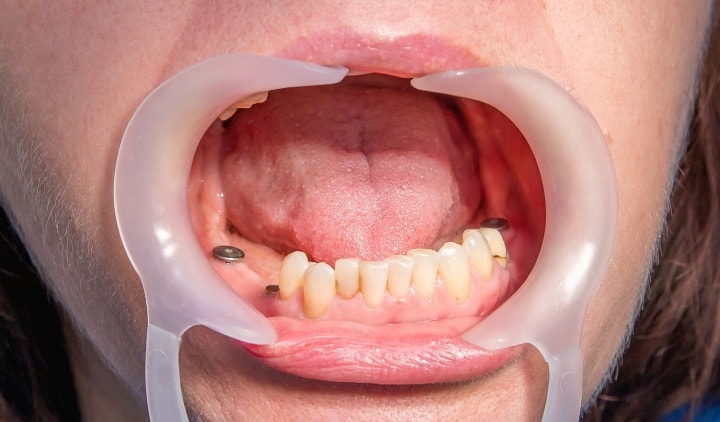
Once the process of osseointegration, where the implant becomes securely fused with the bone, is complete, the next step is installing the abutment. This abutment acts as a connector for the prosthetic crown or denture, and it sticks out slightly from the gums.
To place the abutment, the dentist gently raises the gum tissue above the implant site. They then remove the cover screw, which protects the implant during healing, and replace it with a healing abutment.
After securing the abutment, the dentist carefully stitches the gums around it. It’s important to note that following abutment placement, there is typically a waiting period of around two weeks before the permanent crown can be attached. If desired, during this interim period, patients can discuss with their dentist the option of getting a temporary crown to improve their quality of life and appearance.
The Crown Placement
Once your mouth has fully healed, you’ll schedule another appointment with your dentist to start the process of crafting your crown. During this visit, fresh dental impressions will be taken, and your dental specialist will shape the replacement tooth to fit seamlessly with your existing tooth structure.
Are You a Candidate for Dental Implants?
Congratulations! Most patients are good candidates for dental implants unless otherwise stated. Now, you can assess it even before you talk to your dentist. Ask yourselves the following questions:
1 Are my gums healthy?
2. Do I maintain meticulous oral hygiene by brushing twice a day and flossing once daily?
3. Do I have my blood sugar in the normal range?
4. Is my HbA1c is below 6%?
5. Am I not a tobacco eater?
6. Don’t I have the clenching habits?
If the answer to all the above questions is a YES, then you’re the right candidate for dental implants.
Potential Complications of Implant Surgery

Implant Failure:
As discussed above, implants are made of titanium and screwed into the jawbone. The jawbone then releases certain factors to promote osseointegration, which promotes the natural fitting of the implant into the bone without any adhesives. However, if the bone fails to grow around the implant, the implant will fail. The failure can be attributed to poor surgical technique, poor bone quality, immunocompromised host, overloading, and poor prosthetic design.
Peri-implantitis
This refers to an infection that occurs in the area around the implant. This infection can reduce the bone tissue surrounding the implant, potentially causing the implant to become loose and eventually fall out.
Nerve Injury
Occasionally, during the implant placement procedure, the dental surgeon may position the implant close to a nerve, typically in the lower jaw. When this occurs, you may experience numbness, tingling, or discomfort on the side where the implant was put in.
Sinus Complications
In cases where a sinus lift surgery is not performed, and the implant is placed near the sinus cavity, it can lead to sinusitis. When this occurs, you may experience symptoms such as nose tenderness, bad breath, or a congested nose.
How Much Does a Dental Implant Cost?

Dental implants are expensive. Most Americans are not willing to spend between $1000 to $6000 for a replacement of a single tooth. However, full mouth implants like all-on-4 may cost up to $30,000. The cost varies from practice to practice, location to location and the type of material used.
Any Affordable Means to Finance Dental Implants?
One effective strategy to manage the expense of dental implants is to compare prices diligently. In addition to investigating the cost of dental implants in your immediate vicinity, it’s worth extending your search to neighboring towns and cities. Traveling an extra thirty minutes for treatment might be worthwhile if it results in substantial cost savings, potentially amounting to hundreds of dollars.
Doesn’t it make sense? I’ve better options for you:
Dental Insurance:
Pay a fixed amount monthly amount to get yourself affordable dental care.
Dental Loans:
Get yourself a loan and the treatment together. Repay the cost in installments each month.
Dental Tourism:
Travel to other countries, where you may get the chance to receive quality dental care in fewer bucks.
Does Insurance Cover the Cost of Dental Implants?
Many workplace dental insurance plans are designed to be affordable and cover basic dental stuff. But when you need pricier treatments like fixing deep tooth problems, gum procedures, dentures, or dental implants, those costs usually count toward a particular limit you must pay before insurance kicks in.
When shopping for dental insurance, you might encounter a “waiting period.” This means you must wait a certain amount before your insurance starts covering those pricier treatments. It’s like a time rule that helps the insurance company manage its costs.
So, even if you find a good deal on insurance that promises to help with dental implants, you might have to wait for 6 or 12 months before it helps with those costs. Waiting that long can be challenging if you have a missing tooth, causing problems and making you self-conscious about your smile.
Dental Implant Procedure Follow-Up

Follow-up appointments are meant to monitor healing and to ensure the proper integration of the implant into the jawbone. Your artificial teeth need more care than your natural teeth.
Considering this fact, your dentist will assess your oral hygiene and see if the function is achieved. Periodic follow-ups bi-monthly are scheduled initially, which are later reduced to bi-annual visits to the dentist.
Care of Your Dental Implants
According to the American Academy of Periodontology, the implant system requires thorough care and frequent follow-ups.
For Single Implants:
- Brush your implant with a soft-bristle toothbrush at least twice daily.
- Use a toothpaste that is gentle and not abrasive on your implant.
- Ensure thorough cleaning around and beneath the implant crown.
- Employ a nylon-coated interdental brush for those hard-to-reach areas.
- Floss daily using unwaxed tape or floss specifically designed for implants.
- Consider using an oral irrigator as recommended by your dentist.
For Implant Supported Denture:
- Remove your denture every day and soak it in the recommended cleaning solution for the specified duration.
- Gently brush the underside of your denture using a denture brush.
- Thoroughly rinse your overdenture with water before placing it in your mouth.
FAQ
How long does it take to recover from dental implant surgery?
It usually takes 3 to 6 months to completely recover from the dental implant.
Who shouldn’t get dental implants?
People with poor oral hygiene, smoking, and tobacco chewing habits shouldn’t go for dental implants. People with parafunctional habits like clenching and bruxism should also not go for implants.
Can dental implants be done in one day?
Yes. Same-day dental implants are less invasive, and innovative dental treatments are available. These implants, in medical terms, are also called immediate loading implants.
Are dental implants covered by Medicare?
No. Medicare does not cover expensive treatments unless you’re lucky enough to live in a state with expanded Medicare Dental Coverage.
Are dental implants safe?
According to the American Academy of Implant Dentistry, dental implants are a safe option to replace missing teeth.

